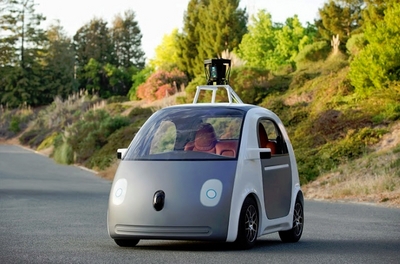2016 CES
Google Beats Detroit By Just Not Showing Up
SEE ALSO: Autonomous Driving May Kill The Automobile Industry
Blog From Edward Niedermeyer
LAS VEGAS January 7, 2016; (Bloomberg) -- As the unsexy, low-margin business of manufacturing and selling cars becomes increasingly swept up in Silicon Valley's vision of disruptive self-driving cars and on-demand mobility, the Consumer Electronics Show has become the place to demonstrate that your car company is more than just another Rust Belt relic.
From the big car brands and their established suppliers to hungry new startups hoping to take on the industry, everyone who has anything to do with cars was in Las Vegas this week was showing off outlandish concepts and new buzzwords.
With one telling exception: Google, the firm most responsible for spooking automakers into embracing bold visions of the future, was a no-show on the automotive stage. And that made it the big winner.
QuickTakeDriverless Cars
The legacy automakers are resigned to the fact that software is eating cars and things will never be the same again, yet they all have wildly divergent views on what the change means, how to deal with it, and even how fast it's coming. These strategic differences bled out into their CES presentations, providing a fascinating look at the state of play in the car business.
For Volkswagen, still reeling from its never-ending diesel emissions scandal, the expo was not all that different from a traditional auto show. The main attraction, a retro-futuristic electric microvan, was much like any other future vision concept it might have unveiled at big industry showcases in Geneva and Frankfurt. A gesture-controlled infotainment system, launching soon on VW's production cars, was more in line with CES's gizmo-obsessed ethos, but it hardly lived up to the existential challenges the industry came to Las Vegas to stare down.
The closest VW got to revealing its response to the Silicon Valley challenge was announcing a partnership with the sensor supplier Mobileye to feed mapping data from its vehicles into its autonomous drive development program. It's a step in the right direction, to be sure, but one that archrivals General Motors and Toyota had already taken.
GM more urgent
General Motors struck a considerably more urgent tone, revealing the Chevrolet Bolt electric car it will start building later this year, and announcing a half-billion dollar investment in the shared-mobility service Lyft. The Bolt, which GM rushed into production in partnership with Korean electronics firm LG, is the latest attempt at a viable green car after the disappointing performance of its hybrid Chevrolet Volt.
Similarly, the Lyft partnership is more defensive move than game-changer: GM is effectively spending half a billion dollars on a hedge against Uber's dominance in the field, but not getting access to the kind of autonomous drive technology that Uber is plowing its venture capital billions into.
Ford had its moment of typical CES frivolity, showing a concept integrating surveillance drones with its F-150 pickup, but otherwise it laid out a well-balanced mix of hardware and software strategies aimed at slowly and methodically pushing into the future of mobility.
It showed off a sleek new Lidar radar sensor for its autonomous car prototypes, while announcing an expansion of its self-driving test fleet. It brought Amazon's Alexa voice-activated assistant into its vehicles, promising to integrate its smart cars with Amazon's smart home functions, and revealed that Toyota would adopt its in-car app interface software.
But Ford made its biggest statement by omission: It didn't announce its rumored deal to license Google's autonomous drive software, which would be first truly momentous joint effort between Detroit and Silicon Valley. Indeed, the fact that Google did not show up to promote its own self-driving car program cast a shadow over all the hype-happy automakers.
The search giant's push into autonomous drive technology has probably been the single greatest factor in the auto industry's current orgy of futurism. If there were really a race between the automotive and tech industries to capture the opportunities of a self-driving, mobility-on-demand paradigm, why weren't the would-be disruptors on hand to scare the old has-beens?
The answer is that they didn't need to be.
The earnest automakers, desperate to demonstrate their ability to move with the times, were more than enough proof that Silicon Valley's disruptive potential is being taken seriously. In fact, some of the would-be disruptors who did join the parade of hype came away looking even less credible than the beleaguered incumbents.
Would-be disruptors
The worst example was without doubt Farraday Future, a secretive electric car startup that squandered huge amounts of goodwill by unveiling a ludicrous 1,000-horsepower single-seat hypercar that looked unlikely to disrupt anything this side of a video game. The moral of the story: When you're on the right side of the disruption narrative, the less said the better ... or risk losing your cachet.
All of which boils down to a fairly absurd set of circumstances, in which a century-old industry that is currently setting sales and profit records must bend over backward to prove how with the times it is. Granted, automakers are chasing CES headlines because their own research shows that change is indeed coming to their business models. For now, however, the concepts and predictions unveiled this week demonstrated who is embracing the change and who is being dragged grudgingly into the future.
As new ideas begin having a more tangible effect on the here-and-now business of the big automakers, expect the drones and gesture-control gimmicks to give way to more vehicles and strategies that really change the way people move about. Only then will it become clear which automakers are serious about taking on the challenges of the future and which are merely adopting Silicon Valley's futurist veneer.



